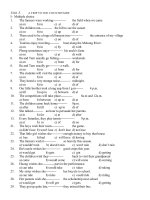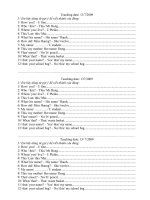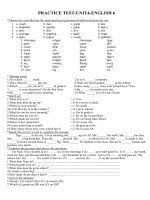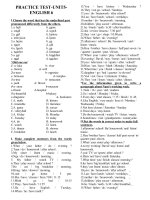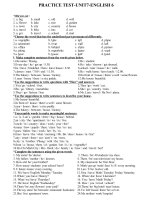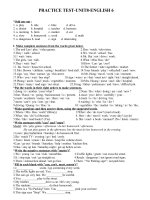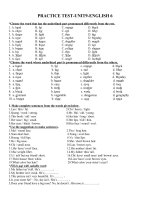Chữa bài tập unit 3
Bạn đang xem bản rút gọn của tài liệu. Xem và tải ngay bản đầy đủ của tài liệu tại đây (604.85 KB, 6 trang )
NGOẠI NGỮ 24H 1
WWW.NGOAINGU24H.VN
PRACTICE UNIT 3
I.
Choose the word which best fits each gap of the sentence
1. Fortunately, I recognized him at the _____, so I left the table and stopped him on time
B. time
A. instant
C. shift
D. distance
2. Any ______ from teachers to students’s progress will make them feel more confident
A. admiration
B. support
D. respect
C. compliment
3. _________ marriage is believed by Asian parents and they don’t let their chilren decide their
marriage by themselves
B. Approval
A. Contractual
C. Commercial
D. Proposal
4. Many American men agree that wives and husbands should ______ in each other and share all
thoughts
A. share
B. confide
C. rely
D. discuss
5. Applicants who are chosen for the job interview next week will be _________ to take a
medical examination
A. begged
B. obliged
C. insisted
D. convinced
6. After the recent scandal, the president is expected to do the ____________ thing and resign
from his position
A. precious
B. kindess
D. formal
C. decent
7. We’ve achieved some __________ results with this drug, but it won’t be suitable for all
patients
B. beautiful
A. marvellous
C. effective
D. vital
8. Some shops have doors which open by themselves at the ________ of a customer
A. need
B. distance
D. method
C. approach
9. These flowers are brightly coloured in order to _____ butterflies
A. impress
B. protect
C. affect
D. attract
10. He was _________ with rage when he knew that he was thought to steal the bicycle
B. angry
A. apoplectic
Đăng ký học: 0962 60 8801 – 04 6260 3948
Địa chỉ: Số 18 Trần Đại Nghĩa – Q Hai Bà Trưng – Hà nội
1
C. miserable
D. sinful
A. GRAMMAR: Choose the best answer
11.
A.
C.
12.
A.
C.
13.
A.
C.
14.
A.
C.
15.
A.
C.
16.
A.
C.
17.
A.
C.
18.
A.
C.
19.
A.
C.
20.
A.
C.
21.
Jane said, “ I sent a letter to my brother.”
Indirect : Jane said that _______ a letter to __________ brother
She has sent/ her
B. She had sent/ her
I has sent/ my
D. I had sent / my
“ It’s the first time I’ve flown
Indirect: Sam said that it ______ the first time _______
Was / he has flown
B. Was / he had flown
Had been / he flew
D. Has been / he flew
“ I’ll see you tomorrow morning, James.”
Indirect: Maria told James that __________ the following morning
I will see you
B. She would see you
I would see him
D. She would see him
“ My son doesn’t like his job,” said Mrs. Smith
Indirect: Mrs. Smith said to me that _________
My son didn’t like my job
B. My son didn’t like his job
D. Her son didn’t like my job
Her son didn’t like his job
“ Nobody has asked me this question before”
Indirect: Susan told me that nobody _________ question before
B. Has asked me this
Had asked her that
Would ask me that
D. Asked her that
“ I’m going away tomorrow, mother”
Indirect: Leo told his mother that __________ away the ______
B. I’m going / day after
He was going / following day
I was going/ day after
D. He’s going / following day
“ These patients don’t obey your order, Doctor”
Indirect: the nurse told the doctor that ______________
Those patient didn’t obey your order
B. Those patient don’t obey his order
These patient don’t obey your order
D. These patient didn’t obey his order
“ Let’s have a picnic this weekend”
Indirect: Erick __________ having a picnic that weekend
asked
B. agreed
D. invited to go out
suggested
“ Why don’t we go out for a drink?”
Indirect: Chris ______ for a drink
Asked to go out
B. Suggested going out
Told us to go out
D. Invited to go our
“ The sun sets in the west”
Indirect: Yesterday the teacher said that the sun _________ in the west
set
B. will set
is setting
D. sets
“ I must pick up my mother at the airport”
Indirect: Alice told me that ________ pick up her mother at the airport
TYPE THE DOCUMENT TITLE
2
NGOẠI NGỮ 24H 3
WWW.NGOAINGU24H.VN
A. I have to
B. I must have to
C. She would have to
D. She had to
22.
“ Don’t go near the water, children”
Indirect: She told the children _________ near the water
A. Can’t go
B. Not to go
C. Don’t go
D. Wouldn’t go
23.
“ Remember to lock the doors when you go out.”
Indirect: The landlord __________ me to lock the doors when____________
B. Asked / I go out
A. Reminded/ I went out
C. Ordered / I go out
D. Suggested / you went out
24.
“ Do it by yourself if you don’t believe what I say
Indirect: The instructor ______ me to do by ____ if I didn’t believe what _________
A. Taught / myself / he says
B. Asked / yourself / I say
C. Reminded / yourself / I said
D. Told / myself/ he said
25.
“ Would you like some coffee?”
Indirect: The woman ________ her some coffee
B. asked
A. invited
C. advised
D. ordered
26.
“ Why don’t you take a rest for a while?”
Indirect: My friend ________ me __________ a rest for a while
A. Offered/ taking
B. Advised / to take
C. Asked/ to take
D. Reminded / taking
27.
“ If you think the room is cold, shut the window, John”
Indirect: My aunt told John ________ the window if ______ the room was cold
A. To shut / you think
B. Shutting/ you thought
D. Shutting/ he thinks
C. To shut / he thought
28.
“ When was the timetable changed?”
Indirect: I asked the man when ________
B. The timetable was changed
A. The timetable had been changed
C. Had the timetable been changed
D. Was the timetable changed
29.
“ Do puppies travel free?”
Indirect: The dog owner asked the ticket seller __________ free
B. If puppies did travel
A. If puppies travelled
C. Whether did puppies travel
D. Whether puppies did travel
30.
“ If I were you, I would take a course of swimming”
Indirect: Andy __________ me ____ a course of swimming
A. Asked / to take
B. Advised / to take
C. Warned / taking
D. Suggested / taking
B. READING
I.
Read the passage and choose the best answer
Đăng ký học: 0962 60 8801 – 04 6260 3948
Địa chỉ: Số 18 Trần Đại Nghĩa – Q Hai Bà Trưng – Hà nội
3
Communicating without words
A. Communication involves words, but it also involves many other things. Very often, we
communicate a great deal without ever opening our mouths. Because we speak with our eyes,
gestures, and expressions, our body language is an extremely important part of communication. In
fact, according to some researchers, as much as sixty percent of communication is nonverbal
B. Nonverbal communication is not the same everywhere, however. Although we all use it, we may use
body language in different ways. This is because each culture has its own "unwritten rules" about
appropriate gestures, eye contact, and so on. Thus, learning language must involve the body
language of that culture. Otherwise, you're learning less than half of the language
C. Our culture determines at least some of our body language . As a result, communication between
people from different countries may be complicated if neither is aware of the body language of the
other. For example, a South American prefers more eye contact and speaks more quickly than a
North American . He or she also uses gestures more frequently. In the Middle East, people stand
nearer to each other than North American are accustomed to. In addition, they often touch each other
during a conversation, but North American do not
D. Difference like these can create problems in communication. Sometimes, although they may not
understand why, people from different cultures feel uncomfortable during conversations. Such
feelings may even cause distrust or disapproval. If this happens to you, you should pay attention to
body language - both yours and the person you're with. Words may not be the problem may not be
the body language.
31.
Our body language plays a major role in communication because we speak with ______
A. our eyes
B. gestures
C. expressions
D. all are correct
32.
According to soem experts, there is about 40 percent of ________ communication
A. unwritten
B. eye contact
D. nonverbal
C. verbal
33.
When using nonverbal communication, it is necessary to understand the unwritten rules
about appropriate gestures, eye contacts ............ because _______
A. Nonverbal communication is not the same everywhere
B. There are different ways of speaking
C. Body language is extremely important
D. Nonverbal communication makes uo to sixty percent
34.
In comparison with a North American, eye contact__________ by a South American
A. May be used in a more complicated way
B. Is used more often
C. Is used differently
D. Is used in a simple way
35.
Because of some differences of the meaning of body language, sometimes people from
different countries _________
A. Are accustomed to nonverbal communication quickly
B. Do not prefer using gestures
C. Feel uncomfortable
D. Create problems in communication
II.
Read the passage and then fill in each blank with the best completion
Body language. What does it say?
More than half of (436)__________ we communicate is communicated not through words but
through body language. This includes our postures, facial expressions, and gestures. (37) _________ body
language is so important, you will want to know what yours is saying and (38) ________ to interpret other
TYPE THE DOCUMENT TITLE
4
NGOẠI NGỮ 24H 5
WWW.NGOAINGU24H.VN
people’s, too. Here are some examples of body language and (39) ______ meaning. (Note: These meanings
are for Norht American. Interpretations may differ a bit in other cultures.)
If your (40) _________ is slumped and your head is down, this (41) ______ mean that you are sad or
lack confidence. If your posture is straight but relaxed, you (42) ______ confidence and friendliness.
A smile is (43) ______ of friendliness and interest. (44) _____ people sometimes smile just to be
polite. To get another (45) _____ from people’s face, notice their eyes. Friendliness and interest are
expressed (46) ______ a person’s eyes meet yours (especially when you are the one who is talking) and then
(47) ______ and meet yours again. A person who doesn’t look away is expressing a (48)_______. A person
who doesn’t look at you is expressing a lack of interest (or is shy).
Hand gestures can mean a person is interested in the conversation. But repeated (49) _______ - like
tapping a pencil or tapping a foot - often mean the person is either impatient or nervous. Stay away from
someone who points (50) _______ you while talking with you: That person might be angry at you or feel
superior to you.
36.
B.
which
C.
where
D.
who
A. what
37. A. Because of
B. However
C. And
D. Because
38. A. how much
C. what
D. why
B. how
39. A. theirs
B. their
D. it’s
C. its
40. A. posture
B. appearance
C. body
D. shape
41. A. must
C. would
D. should
B. could
42. A. can express
B. will express
C. express
D. are expressing
43. A. a model
B. a note
C. a track
D. a sign
44. A. Although
B. When
D. So
C. But
45. A. meaning
C. evidence
D. posture
B. clue
46. A. when
B. before
C. as
D. after
47. A. look over
B. look up
C. look at
D. look away
48. A. hint
B. warning
D. hatred
C. challenge
49. A. movements
B. postures
C. signs
D. figures
50. A. on
C. to
D. with
B. at
D.ERROR INDENFICATION : Identify the error in each sentence
51. Shaking hands upon greeting and parting is customary in France. The handshake should be
A
B
firmed, but an aggressive handshake is considered impolite
C firm
D
52. Greetings are usually combined with the person’s name or a title, and usually precedes any
A
B
C
D precede
conversation or request
53. Vietnamese generally shake hands when greeting and parting. Using both hands show respect
A
B
C shows
as does a slight bow of the head
D
54.For most social situations where some informality is allowed, a brief raise of hand and a
A in
B
C
small wave is fine
D
Đăng ký học: 0962 60 8801 – 04 6260 3948
Địa chỉ: Số 18 Trần Đại Nghĩa – Q Hai Bà Trưng – Hà nội
5
55. To atract someone’s attention so as we might speak to that person, we can use either verbal
A
B so that
C
D
or non-verbal forms of communication
56. The communication mode what we rely on most often to carry meaning from one person to
Awhich
B
C
another is the verbal mode
D
57. One’s nonverbal communication, or body language, is usually involuntary, and the nonverbal
A
B
signals are expressed through behaviour as well as verbally and also has symbolic meaning
C
D have
58. Some people give out nonverbal body signals that say that they do not want to be touched,
A
and there are other people who describe themselves and are describing by others as “ touchy
B
C
D are described
freely
59. Eye contact has the third form of nonverbal communication. We tend to size each other up
A is
B
in terms of trustworthiness through reactions to each other’s eye contact
C
D
60. We tend to place distance between ourselves and others thanks to the kinds of relationships
A
B based on
that we have and what our motives are toward each other
C
D
E. Writing
Use the words to make sentences. Change the form of verbs if necessary
1. An important/ thank people / be/ of every culture
Thanking people is an important part of every culture
2. For many things, / include information, / invitations and complements/ we thank people
We thank people for many things, including information, invitations and complements
3. Express / ways / our/ we / gratitude / in many
We express our gratitude in many ways
4. For something / after you be thanked / the common / most / response / be / “ You are welcome”
After you have been thanked for something, the most common response is “ You’re welcome”
5. Other ways / there be / respond / too, but / they / be not mention / here
There are other ways to respond too, but they are not mentioned here
TYPE THE DOCUMENT TITLE
6
